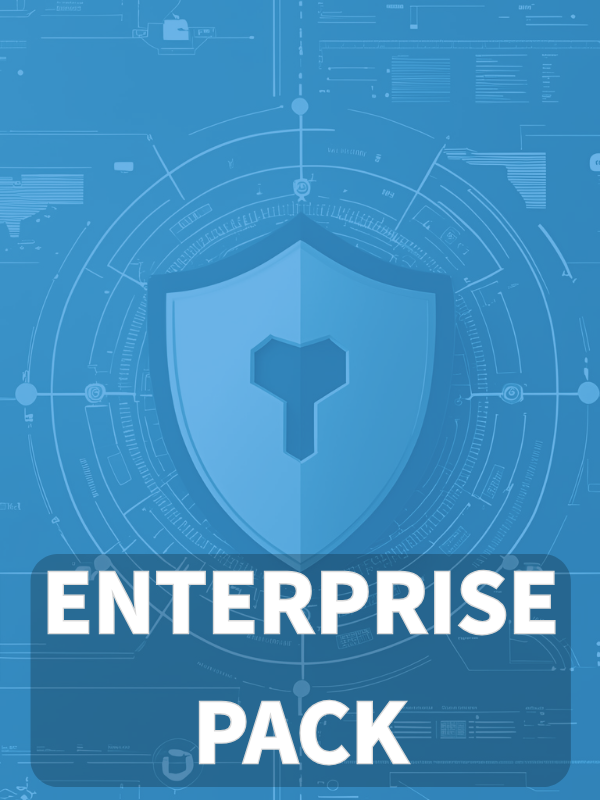Overview
A strategic policy addon for enterprise NIS2 compliance, addressing supplier risk management, red-team security testing, vulnerability disclosure, and enforced multi-factor authentication and secure communications.
Mitigate Supplier Risks
Systematic management of supplier dependency and concentration risks in line with NIS2 and sector guidelines.
Continuous Security Validation
Structured security testing and red-teaming policies to identify vulnerabilities before adversaries do.
Responsible Vulnerability Disclosure
Streamlined coordinated vulnerability reporting and safe handling to meet regulatory mandates.
Enforced MFA & Secure Comms
Mandatory multi-factor authentication and encrypted communications strengthen access and data confidentiality.
Read Full Overview
What's Inside
Supplier Dependency Register & Risk Ratings
Security Testing & Red-Team Engagement
Coordinated Vulnerability Disclosure Channel
Multi-Factor Authentication Implementation
Secure Emergency Communications System
Audit & Review Procedures for All Domains
Framework Compliance
🛡️ Supported Standards & Frameworks
This product is aligned with the following compliance frameworks, with detailed clause and control mappings.
| Framework | Covered Clauses / Controls |
|---|---|
| ISO/IEC 27001:2022 | |
| ISO/IEC 27002:2022 | |
| NIST SP 800-53 Rev.5 | |
| EU GDPR |
Art. 28Art. 32(1)(b)Art. 32(1)(d)
|
| EU NIS2 | |
| EU DORA | |
| COBIT 2019 |
Related Policies
Governance Roles And Responsibilities Policy
Clarifies ownership for supplier risk decisions.
Information Security Policy
Assigns accountability for supplier dependency governance.
Risk Management Policy
Embeds concentration risk into enterprise risk registers.
Vulnerability And Patch Management Policy
Internal remediation pipeline linked to CVD intake.
Secure Development Policy
Integrates test findings into SDLC controls.
Application Security Requirements Policy
Ensures requirements reflect test learnings.
Third Party And Supplier Security Policy
Baseline security; P41 adds dependency/concentration controls.
Cloud Usage Policy
Applies dependency criteria to cloud service adoption and exit plans.
Outsourced Development Policy
Covers dependency risks in external engineering.
Incident Response Policy
Handles active exploitation of disclosed vulnerabilities.
Evidence Collection And Forensics Policy
Preserves artifacts from reported/exploited flaws and collects artifacts safely during testing.
Business Continuity And Disaster Recovery Policy
Plans for supplier outage/substitution scenarios and verifies resilience under attack.
Audit And Compliance Monitoring Policy
Independent oversight of testing program effectiveness.
Legal And Regulatory Compliance Policy
Ensures contracts/obligations reflect dependency controls and governs notification, safe-harbor wording, and publication.
Access Control Policy
Establishes access governance that MFA in P38 enforces.
User Account And Privilege Management Policy
Ties MFA to privileged access lifecycle.
Cryptographic Controls Policy
Provides approved crypto/key management for secure comms.
Network Security Policy
Secures transport channels used by voice/video/messaging.
Logging And Monitoring Policy
Monitors authentication events and secure-channel usage; validates detection coverage during exercises.
Information Security Awareness And Training Policy
Trains users on MFA and channel hygiene.
About Clarysec Policies - NIS2 Addon
Effective security governance requires more than just words; it demands clarity, accountability, and a structure that scales with your organization. Generic templates often fail, creating ambiguity with long paragraphs and undefined roles. This policy is engineered to be the operational backbone of your security program. We assign responsibilities to the specific roles found in a modern enterprise, including the CISO, IT Security, and relevant committees, ensuring clear accountability. Every requirement is a uniquely numbered clause (e.g., 5.1.1, 5.1.2). This atomic structure makes the policy easy to implement, audit against specific controls, and safely customize without affecting document integrity, transforming it from a static document into a dynamic, actionable framework.
Modular and Audit-Ready
Every control is mapped, versioned, and designed for direct implementation and audit tracking across enterprise environments.
Continuous Improvement Embedded
Annual reviews, simulation drills, and lessons learned ensure that policy and controls evolve as new risks and technologies emerge.
Frequently Asked Questions
Built for Leaders, By Leaders
This policy was authored by a security leader with 25+ years of experience deploying and auditing ISMS frameworks for global enterprises. It's designed not just to be a document, but a defensible framework that stands up to auditor scrutiny.
